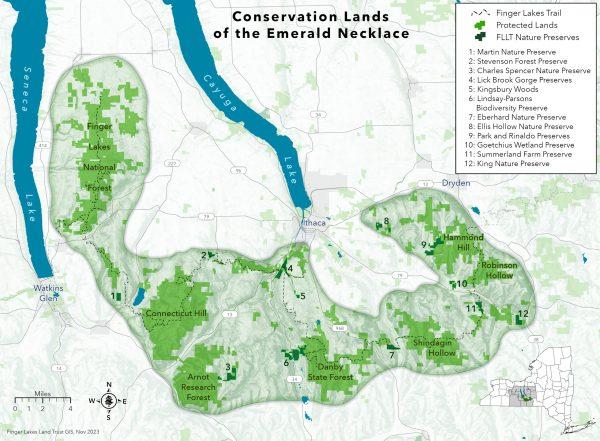The Finger Lakes region stretches over 9,000 square miles and recreation opportunities draw both locals and tourists to the area. The 11 Finger Lakes and surrounding rural landscape provide opportunities to enjoy the outdoors, but environmental threats like development make the area vulnerable to habitat loss, degradation and fragmentation.
To help combat this issue, groups like the Finger Lakes Land Trust (The Land Trust) work to conserve land while encouraging responsible recreation on preserved areas.
The nonprofit’s mission statement is to “conserve forever the lands and waters of the Finger Lakes region, ensuring scenic vistas, clean water, local foods, and wild places for everyone,” and since its formation in 1989 has conserved over 30,000 acres of land.
Conservation through The Land Trust comes through the creation of public nature preserves, conservation areas and easements on private lands.
Collaboration adds land to the emerald necklace
Last month, The Land Trust completed a partnership with the Cornell Botanic Gardens to preserve 81 acres of land adjacent to the Fischer Old-Growth Forest. The preserved area is wetland and mixed hardwood forest which acts as a buffer for the old-growth forest that is home to at least 23 species of trees including a locally rare yellow oak. The newly added protected area will also help filter runoff to the Cayuga Inlet.
Started in 2006, the Emerald Necklace goal works to preserve land around the southern end of Cayuga Lake to form an unbroken chain of protected land. Kate Riley, land conservation specialist with The Land Trust and project manager for the Fischer Old-Growth Forest addition, said that the project continues to make progress in adding protected lands to the green corridor.
According to the National Wildlife Federation, green corridors allow wildlife to move through a region safely which is critical with development and climate change forcing many animals to move.

Preserving a family legacy
David Bock and his family worked with The Land Trust to protect their land in Enfield by creating the Bock-Harvey Forest Preserve in 2013. The area is now owned by the Finger Lakes Trail Conference with a conservation easement held by The Land Trust.
Bock talked about the history of the land and why it was important to his family to preserve it. The land was part of the Central New York Military Tract which was land taken from the Cayuga and Onondaga Nations. The land was then bought by Samuel Harvey in the early 1800s. The 48 acres of land has been in Bock’s family for six generations and is home to a stand of old growth maples Bock said are thought to be between 250 and 400 years old.
“The woods are [now] preserved forever, which is about as close as we could get to our grandmother’s wishes,” Bock said. … “Nobody in the family could stand the thought that someone would come in and harvest all of these old growth maples for furniture or something, that these woods would disappear.”
Bock said he is grateful for the work of The Land Trust, which he feels will help safeguard the natural areas in the Finger Lakes.
“Without their activity, fast forward 50 to 100 years and some of these areas we now see as beautiful and available for recreation might well not survive,” Bock said. “And that’s actually what’s the driving force behind our donation to The Land Trust.”
Additional conservation programs
The Land Trust isn’t the only group preserving land in the region, as groups like The Wetland Trust also work in this field across the state. The New York State Department of Environmental Conservation also has a conservation easement program and local governments work to preserve land including the Town of Danby’s Conservation Advisory Council which was created in 2010.
Nine volunteer members serve on Danby’s council which has a conservation easement program to help town members who want to preserve their land. Margaret Corbit, co-chair of the council said that the program has seven completed easements and four or five that are in active development right now.
Corbit said preserving land to prevent habitat fragmentation and provide space for people to enjoy the outdoors is important to her.
“It’s become really clear to me how important making nature available to the residents of an area is,” Corbit said. “They really do get out and enjoy it, they do use it [and] they do appreciate it.”
Enjoying the environment one hike at a time
Ithaca Hikers is an organization that offers group hikes and a welcoming community to outdoor enthusiasts year-round. Group organizer and hike leader Jim Rolfe said with over 300 members on the email list, the group often has between 25-40 attendees for summer hikes and sees young and old community members alike on their excursions.

Hiker Elizabeth Regan talked about how important she feels it is to keep land undeveloped to help wildlife and preserve natural areas that people can enjoy through recreation like hiking.
“Over time conservation and environmental health has become more and more urgent as the planet turns to toast or gets paved over,” Regan said. “There is a need for the health of people and wildlife to have undeveloped areas.”



















